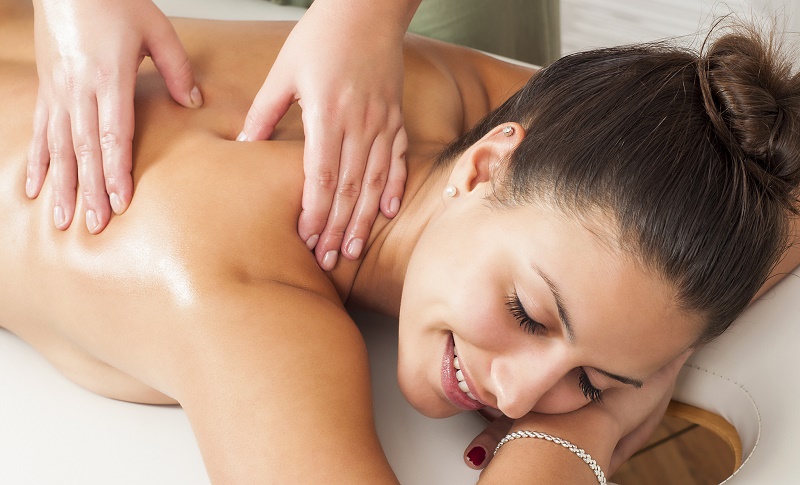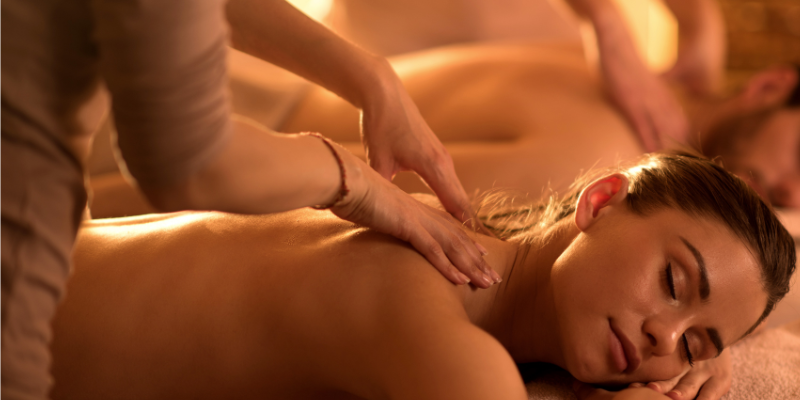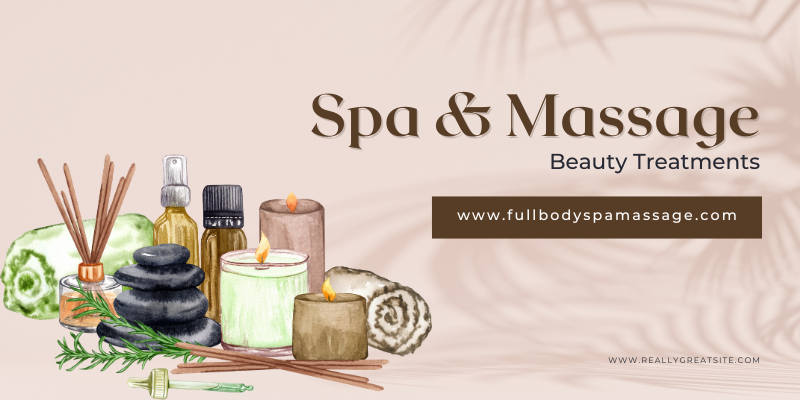
FULL BODY MASSAGE ? Let the worries of the day fade away as our expert hands work their magic, promoting deep relaxation, improved circulation, and enhanced well-being. Treat yourself to the ultimate indulgence with our Full Body Massage, and embark on a journey to total relaxation and inner peace.
At our body spa, skilled therapists use expert techniques to dissolve stress and tension from every muscle, leaving you feeling revitalized and renewed.
A full body massage is a therapeutic procedure in which a skilled massage therapist manipulates the muscles and soft tissues all over the body using a variety of techniques. A complete body massage’s main objectives are to promote relaxation, relieve muscle tension, increase blood circulation, and improve general wellbeing. It entails the methodical use of pressure, strokes, and movements to various body parts, treating particular difficulties and offering a comprehensive sense of relaxation.
The therapist may apply methods including effleurage (long, gliding strokes), kneading, friction, tapping, stretching, and more during a full-body massage. Whether the customer prefers soft, soothing strokes or firmer pressure to target particular pain points, the massage can be tailored to suit their tastes.
A complete body massage often targets the back, shoulders, neck, arms, hands, legs, and feet, as well as the head and face occasionally. In order to maintain privacy and modesty throughout the session, the client often undresses to their degree of comfort, lies on a massage table, and is appropriately wrapped with a sheet or towel.
A certified massage therapist gives a full body massage in a respectable, professional manner while maintaining an atmosphere of safety and respect. To guarantee the best experience possible, it’s critical to discuss any preferences, worries, or medical issues with the therapist prior to the session.
No, massaging the breasts is not considered to be a proper form of massage. A valid massage session seeks to promote relaxation, ease tension in the muscles, and improve general wellbeing. Breast massage is not regarded as a suggested or appropriate method in professional massage therapy.
Massage therapists are trained to respect boundaries and provide a safe and comfortable environment for their clients. They follow a strict code of ethics that bans them from engaging in any unethical or sexual behavior when giving massages. If you ever have a massage therapist who makes you feel uncomfortable, it’s critical to end the appointment right away and report the practitioner’s inappropriate behavior to the appropriate authorities or the facility where the treatment was provided.
It is advised to select a registered and certified massage therapist from a recognized facility if you’re seeking massage treatment for any particular difficulties in order to guarantee a secure and competent experience.
The amount of clothing you should take off for a massage depends on your personal comfort level and the type of massage you’re receiving. Generally, the goal is for you to feel relaxed and at ease during the session.
Here are some guidelines to consider :
Underwear : The majority of massage techniques are made to be applied while the client is still in their underpants. It is more comfortable and modest for the massage therapist to work when dressed in underpants. However, if it makes you feel more comfortable, you can decide to take your underpants off.
Bras : It is normally advised that ladies take their bras off prior to receiving a back massage. This enables the masseuse to reach and treat the entire back and shoulder region. However, you should act in a manner that gives you the most comfort. Some women favor wearing their bras all the time.
Undressing: The purpose of massage therapy is to relax you, and massage therapists are taught to respect your dignity and privacy. You can get dressed as comfortably as you like and then get on the massage table while they are out of the room. During the massage, only the area being worked on will be exposed because you will be properly wrapped with a sheet or towel.
Communication: The massage therapist will discuss your level of comfort with you before to the massage and explain how to situate yourself on the table. Don’t be afraid to ask for advice if you’re unsure of what to take off or how to stand.
Modesty: To make sure that only the region being worked on is exposed, the massage therapist will employ draping techniques. You will always keep your breasts and genitalia covered, if you’re a lady.
Keep in mind that your comfort and wellbeing come first. Feel free to share any particular worries or inquiries you may have with the massage therapist prior to the appointment if you have any regarding what to wear while receiving a massage. They will make every effort to respect and uphold your preferences while maintaining a professional environment

During a massage, it’s important to observe proper etiquette and behavior to ensure a respectful and comfortable experience for both you and the massage therapist. Here are some things you should not do during a massage
During a massage, it’s important to observe proper etiquette and behavior to ensure a respectful and comfortable experience for both you and the massage therapist. Here are some things you should not do during a massage:
Inappropriate Behavior: Do not engage in any inappropriate or sexual behavior during the massage. Massage therapy is a professional and therapeutic service, and any sexual advances or comments are not appropriate.
Tipping with Inappropriate Intentions: If you choose to tip your massage therapist, do so as a gesture of appreciation for their professional service, not as a means to solicit inappropriate behavior.
Excessive Talking : While some conversation is fine, avoid talking excessively during the massage. Many people prefer to relax in silence during the session.
Not Communicating Preferences : If you have specific preferences or concerns about pressure, areas to focus on, or any discomfort, communicate these to the massage therapist before or during the session. They want to ensure your comfort and satisfaction.
Being Late : Arrive on time for your appointment to ensure you receive the full duration of the massage. Being late can impact your own experience and that of other clients.
Using Your Phone: Turn off or silence your phone before the massage begins. Using your phone can be distracting and disrupt the tranquil atmosphere.
Not Disclosing Health Conditions : Inform your massage therapist about any health conditions, injuries, allergies, or other concerns that might affect the massage. This allows them to tailor the session to your needs.
Ignoring Hygiene: Good hygiene is important for both you and the massage therapist. Take a shower before your massage if possible.
Drinking Alcohol or Being Under the Influence: Avoid consuming alcohol or substances that could impair your judgment or affect your physical responses before a massage.
Stiffening Muscles : Try to relax your muscles during the massage. If you’re tense or stiff, it can be more challenging for the therapist to provide an effective massage.
Not Giving Feedback: If something during the massage is uncomfortable or not to your liking, let the therapist know. They can adjust their approach to ensure you have a positive experience.
Not Following Therapist’s Instructions: If the therapist provides instructions on positioning or breathing techniques, follow them to enhance the effectiveness of the massage.
Bringing Valuables: Avoid bringing valuable items to the massage. Most establishments provide a secure place for your belongings, but it’s best to leave valuables at home.
Remember that massage therapy is meant to be a relaxing and therapeutic experience. Respecting the boundaries, professionalism, and expertise of the massage therapist will contribute to a positive session for both you and the therapist.

The frequency of receiving a full body massage can vary depending on individual needs, preferences, and circumstances. There isn’t a one-size-fits-all answer, as different people have different levels of stress, physical activity, and overall wellness goals. Here are some general guidelines to consider:
Stress Relief and Relaxation: You may want to think about getting a full body massage once a month or every few weeks if your main objective is to relax and relieve tension. You can relax and reduce tension by doing this.
Chronic Pain or Muscle Tension: More frequent massages may be helpful if you struggle with chronic pain or muscle strain. In these situations, you might think about starting with massage appointments every one to two weeks and progressively extending the interval between appointments as your symptoms become better.
Athletes and Active Individuals: Receiving a massage once a week or every other week can aid in the rehabilitation of your muscles and help you avoid injuries if you’re an athlete or indulge in regular, strenuous physical exercise.
Health Conditions: More regular massages may be beneficial for people with particular health issues, such as certain types of injuries or medical disorders. To choose an appropriate schedule, speak with your doctor and a licensed massage therapist.
Maintenance and Wellness: Some people choose to include frequent massages in their overall wellness regimen. In order to preserve mental and physical health and avoid tension building, this can include receiving a massage every four to six weeks.
Budget and Time: How frequently you can receive massages will also depend on your money and schedule. Think about what is affordable for you in terms of both time and money commitment.
It’s crucial to pay attention to your body’s signals and how massage therapy affects it. You may have an idea of how frequently you’d like to have massages if you find that you feel better and have less tension after one. Additionally, it’s important to communicate with your massage therapist because they can make tailored recommendations based on your objectives and particular requirements.
Keep in mind that consistency can frequently result in superior outcomes. Instead of only thinking about getting a massage once, consider how regular appointments could improve your general wellbeing and stress reduction. To find out how often you should have massages, always seek the advice of a trained medical practitioner or a massage therapist who is certified in their field.
To ensure a comfortable and enjoyable full body massage experience, it’s a good idea to prepare a few things beforehand. Here’s a list of items and considerations to help you prepare for your massage:
Appointment Confirmation: Confirm the date, time, and location of your massage appointment. Make sure you have the necessary details, including any directions to the massage facility.
Hygiene: Take a shower before your massage to ensure good personal hygiene. This is considerate both for yourself and the massage therapist.
Clothing: Wear comfortable clothing to the massage appointment. Loose-fitting garments are preferable, as they make it easier to change into the robe or disrobe for the massage.
Arrival Time: Arrive a few minutes early for your appointment. This will give you time to complete any necessary paperwork and settle in before the massage begins.
Paperwork: Some massage establishments might require you to fill out a health questionnaire or consent form. Be prepared to provide any necessary information about your health history, allergies, or preferences.
Communication: Communicate your preferences, any areas of concern, and your comfort level with the massage therapist. Clear communication ensures that the massage is tailored to your needs.
Payment: If the payment isn’t already settled, bring the necessary form of payment, such as cash, credit card, or any necessary documentation for insurance purposes.
Jewelry and Valuables: Remove jewelry and any valuables before the massage. Most establishments provide a secure place for your belongings, but it’s best to leave valuables at home.
Allergies and Sensitivities: If you have allergies or sensitivities to certain products (e.g., oils, lotions, scents), inform the massage therapist before the session.
Medical Conditions and Medications: If you have any medical conditions or are taking medications, let the massage therapist know. This information can help them tailor the massage to your specific needs.
Relaxation Time: Arrive with enough time to relax before the massage. Rushing to the appointment can negate the relaxing effects of the massage.
Mentally Prepare: Take a few moments to mentally prepare for relaxation. Consider disconnecting from work-related matters and any stressors.
Silence Your Phone: Turn off or silence your phone before entering the massage room to minimize distractions.
Bathroom Break: Use the restroom before the massage to avoid interruptions during the session.
Breathing and Relaxation Techniques: During the massage, practice deep breathing and relaxation techniques to help your body and mind unwind.
After-Massage Plans: Consider your plans after the massage. You might want to avoid strenuous activities immediately after to fully enjoy the benefits of relaxation.
By following these preparations, you can ensure that you have a smooth and enjoyable full body massage experience. Remember that the goal of the massage is to help you relax and rejuvenate, so create an environment that supports that intention.
The phrase “happy ending” is frequently used in the context of massage facilities or parlors to describe a sexual act or service that is provided after a massage session. It suggests a sexual favor or behavior outside the bounds of a proper and expert massage therapy session.
It’s crucial to remember, though, that offering sexual services as part of a massage session is immoral, illegal in many jurisdictions, and contravenes the moral standards required of certified massage therapists. Legitimate massage practitioners abide by a strict code of ethics that emphasizes giving clients therapeutic advantages, relaxation, and stress alleviation without any overt sexual overtones.